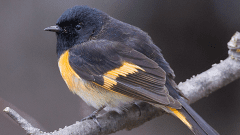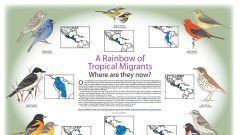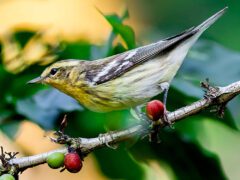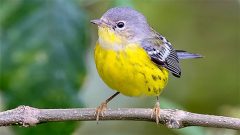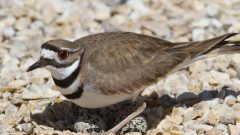Baltimore Oriole Photo Gallery
Adult male
Medium-sized, sturdy-bodied songbird with a thick neck, long legs, and pointed bill. Adult males have an entirely black head and back with an orange rump and orange outer tail feathers.
© Fernando Burgalin Sequeria / Macaulay LibraryAlajuela, December 29, 2018Adult female
Thick-necked songbird with a long, pointed bill. Adult female plumage is highly variable ranging from a brownish to yellowish head and back. Note yellow tail and yellow undertail coverts.
© Ryan Schain / Macaulay LibraryMassachusetts, May 11, 2011Adult male
Note fairly long, sharply pointed bill—a useful feature to identify members of the blackbird family. Males are brilliant orange and black, with orange shoulder patch and broad white wingbar.
© Daniel Jauvin / Macaulay LibraryQuebec, May 15, 2021Not all videos have soundAdult female
Female plumage is highly variable. Some have brownish heads and backs. Note yellow tail and undertail coverts.
© Bob Dunlap / Macaulay LibraryMinnesota, May 10, 2011Immature female
Immature females have a grayish back with faint streaking and a pale yellow wash on the head and breast. Note yellow tail.
© Sarah Gustafson / Macaulay LibraryVirginia, January 18, 2017Adult male
Song is a rich whistle, rising and falling in a few phrases.
© Benjamin Clock / Macaulay LibraryMichigan, June 04, 2011Not all videos have soundFemale/immature male
Females and immature males are variable, but note pointed bill, yellowish-orange underparts, and two white wingbars.
© Marky Mutchler / Macaulay LibraryIowa, May 29, 2017Adult male
Flashes yellowish to orange outer tail feathers in flight.
© kurt countryman / Macaulay LibraryWyoming, May 19, 2017Adult male
Orioles often come to oranges offered at backyard feeding stations.
© Eric Liner / Macaulay LibraryNew York, May 01, 2006Not all videos have soundAdult male
Found in open woodland, forest edge, orchards, and stands of trees along rivers, in parks, and in backyards.
© Andrew Spencer / Macaulay LibraryOntario, May 06, 2015Female
Eats berries, other fruits, nectar, and insects.
© Alix d'Entremont / Macaulay LibraryNova Scotia, November 30, 2020Adult male
Usually forages in treetops among fine twigs and leaves, where it can be hard to see despite its bright colors.
© Benjamin Clock / Macaulay LibraryMichigan, June 04, 2011Not all videos have soundAdult male
Often visits fruit feeders. Note orangish outer tail feathers and black hood.
© Winston Poon / Macaulay LibraryOntario, May 19, 2017Compare with Similar Species
Click on an image to compare
Species in This Family
Troupials and Allies(Order: Passeriformes, Family: Icteridae)
More to Read
Don't miss a thing! Join our email list
The Cornell Lab will send you updates about birds,
birding, and opportunities to help bird conservation.


























